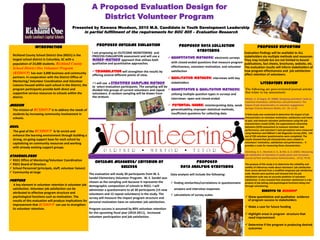Kawana woodson.researchposter
- 1. A Proposed Evaluation Design for District Volunteer Program Presented by Kawana Woodson, 2010 M.S. Candidate in Youth Development Leadership in partial fulfillment of the requirements for SOC 805 ŌĆō Evaluation Research INTRODUCTION Richland County School District One (RSD1) is the largest school district in Columbia, SC with a population of 23,000 students. Richland County School District One Volunteer Program (RSDOVP) has over 3,000 business and community partners. In cooperation with the District Office of Mentoring/ Volunteer Coordination and Volunteer Liaisons housed within each school in the District, the program participants provide both direct and supportive service resources to schools within the district. PROPOSED OUTCOME EVALUATION I am proposing an OUTCOME MONITORING and PROCESS EVALUATION assessment and will use a mixed-method approach that utilizes both qualitative and quantitative approaches. PROPOSED DATA COLLECTION STRATEGIES Evaluation findings will be available to ALL ’ā╝ Quantitative methods: electronic surveys stakeholders via multiple methods and resources. They may include but are not limited to bound with closed-ended questions that measure program publications, fact sheets, brochures, website, etc. effectiveness, volunteer motivation, and volunteer The evaluation results will inform stakeholders of how program effectiveness and job satisfaction satisfaction ’ā╝Triangulation will strengthen the results by affect retention of volunteers. offering several different points of view. ’ā╝ Qualitative methods: interviews with key stakeholders ’ā╝I will use a stratified sampling method LITERATURE REVIEW to select evaluation participants. The sampling will be The following are peer-reviewed journal articles divided into groups of current volunteers and repeat ’ā╝ Quantitative & Qualitative methods: that relate to my assessment: volunteers. A random sampling will be drawn from utilizing multiple question types in surveys and the stratum. interviews- open and closed-ended Millete, V., & Gagne, M. (2008). Designing volunteers' tasks to Mission ’ā╝ Potential Issues: misinterpreting data, weak generalizability, improper statistical methods, insufficient questions for collecting data The mission of RCSDOVP is to address the needs of students by increasing community involvement in schools. Goal The goal of the RCSDOVP is to enrich and enhance the learning environment through building a strong, on-going support base for each school by capitalizing on community resources and working with already existing support groups. Stakeholders ’ā╝ RSD1 Office of Mentoring/Volunteer Coordination ’ā╝ RSD1 Board of Directors ’ā╝ School Personnel (principals, staff, volunteer liaison) ’ā╝ Community-at-large PROPOSED REPORTING OUTCOME MEASURES/ CRITERION OF SUCCESS The evaluation will study 30 participants from W. S. Sandel Elementary Volunteer Program. W. S. Sandel was Purpose chosen as the sampling unit because it represents the A key element in volunteer retention is volunteer job demographic composition of schools in RSD1. I will satisfaction. Volunteer job satisfaction can be administer a questionnaire to all 30 participants (15 new attributed to effective program structure and volunteers and 15 repeat volunteers) in the study. The psychological functions such as motivation. The survey will measure the impact program structure and results of this evaluation will produce implications for personal motivation have on volunteer job satisfaction. improvement that RCSDOVP can use to strengthen its volunteer retention. Program success is assumed by 80% volunteer retention for the upcoming fiscal year (2010-2011), increased volunteer participation and job satisfaction. PROPOSED DATA ANALYSIS STRATEGIES Data analysis will include the following: ’ā╝ finding similarities/correlations in questionnaire answers and interview responses ’ā╝ calculations of survey scales maximize motivation, satisfaction, and performance: The impact of job characteristics on volunteer engagement. Springer Science+Business Media, LLC , 32, 11-22. A field study was conducted to determine the impact of job characteristics on volunteer motivation, satisfaction and intent to quit, and measure volunteer performance using the job characteristics model (JCM), the organizational citizenship behaviors (OCB) assessment to measure volunteer task performance, and volunteerŌĆÖs task perceptions were measured using Hackman and Oldham's Job Diagnostic Survey (JDS). 124 out of 230 volunteer questionnaires were completed. The results showed that job characteristics were related to volunteers' motivation, satisfaction and performance.. It provides a scale for measuring these characteristics. Silverberg, K. E., Marshall, E. K., & Ellis, G. D. (2001). Measuring job satisfaction of volunteers in public parks and recreation. Journal of Park and Recreation Administration , 19 (1), 79-92. The purpose of this study is to determine the reliability and validity of inferences made about volunteersŌĆÖ job satisfaction from scores derived from a modified employee job satisfaction scale. Results were positive and showed that the job satisfaction scale was an accurate predictor of volunteer satisfaction. It also revealed that volunteer satisfaction is a byproduct of job setting and psychological functions being met through volunteering. BENEFITS TO RCSDOVP ’ā╝ Show quantitative and qualitative evidence of program success to stakeholders ’ā╝ Make a case for future funding ’ā╝ Highlight areas in program structure that need improvement ’ā╝ Determine if the program is producing desired outcomes
